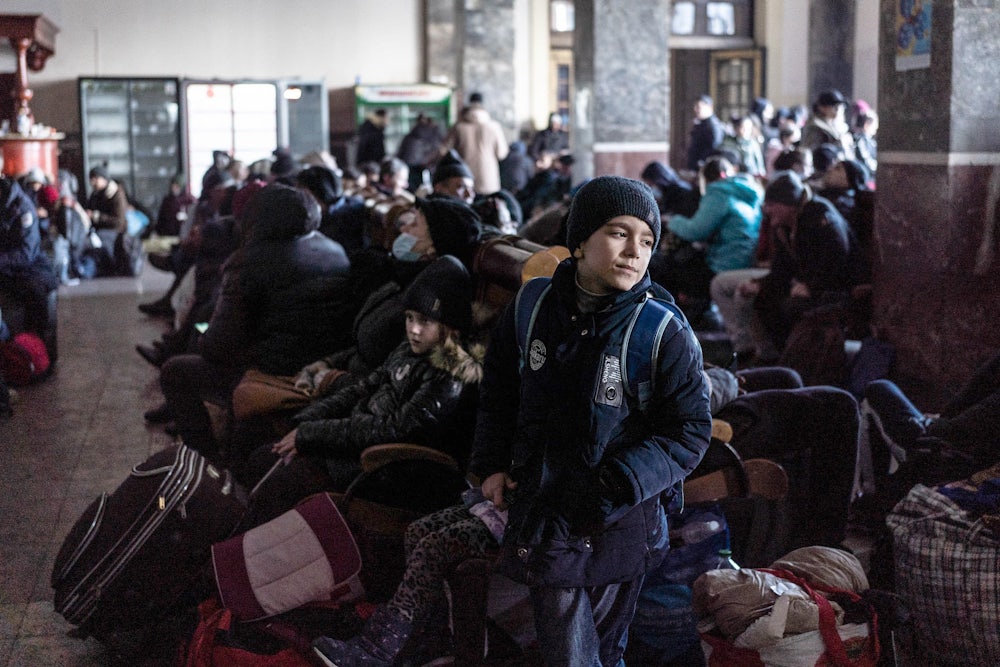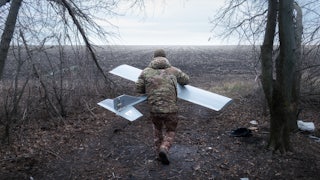Russia’s invasion of Ukraine, closely watched by its European neighbors and the rest of the world, has prompted a mass exodus of hundreds of thousands fleeing their homes. In all likelihood, this will become the greatest displacement of European people since World War II. As the situation evolves, the United States will have to calibrate its response to the conflict, not only with crippling sanctions targeting Russia and military aid to Ukraine but with assistance to address the growing humanitarian crisis.
The United Nations estimates that, as of Monday, more than 500,000 refugees had fled from Ukraine into neighboring countries. The European Union commissioner for crisis management said Sunday that if Russian aggression continues, “over seven million people” could be displaced; U.S. officials have estimated that it could be around five million people displaced, in line with U.N. numbers.
Rachel Denbar, the deputy director of the Europe and Central Asia Division at Human Rights Watch, described the difficulties that Ukrainian people were facing in trying to leave the country. “My colleagues on the ground in Ukraine saw lines at one of the border crossings with Poland that stretched at least 40 kilometers across the highway in freezing temperatures, with no humanitarian assistance along the way. So, no water stations, no food stations, no warming stations, no toilets,” she said.
Denbar also said that a person Human Rights Watch spoke to spent three days waiting to cross over the border to Romania. Border guards have been instructed by Ukrainian President Volodymyr Zelenskiy to stop all male citizens between the ages of 18 and 60 from leaving the country, instead ordering them to stay and fight.
The burden of accepting and resettling Ukrainian refugees will primarily fall on European countries, which may be more eager to accept their fleeing neighbors than they were to admit the more than one million Syrian refugees who fled to Europe in 2015, as that nation plunged into civil war. Ukrainians are permitted to stay in EU countries without a visa for up to 90 days, and the EU has agreed to allow Ukrainian refugees to stay for up to three years without applying for asylum. (On Monday, Zelenskiy requested that officials fast-track Ukraine’s membership in the EU.)
“A lot of Ukrainian people have ties, family and friends and colleagues, across Europe,” said Julia Gelatt, a senior policy analyst at the Migration Policy Institute. “Some Ukrainians may end up coming to the United States, but probably this will easily be a European issue, and a big role the U.S. can play is financial and logistical, and other support through international agencies like [the United Nations High Commissioner for Refugees].”
From across the Atlantic, the U.S. has taken steps to bolster Ukraine militarily and provide humanitarian assistance. Many of the more than five thousand U.S. troops in Poland had helped to set up processing centers for people fleeing Ukraine. Secretary of State Antony Blinken announced Sunday that the U.S. will send $54 million in humanitarian aid to support “ordinary Ukrainians” affected by the invasion. A State Department spokesperson noted to The New Republic that, with this contribution, the U.S. has provided nearly $405 million in humanitarian aid to Ukraine since Russia invaded Crimea in 2014. The spokesperson said the U.S. is “closely coordinating with international partners to monitor the situation in Ukraine and will work with them to address humanitarian needs in Ukraine and in the region.”
“The Department is engaging diplomatically to support neighboring countries, as needed, to continue to keep their borders open to those seeking international protection, including those who may experience communication barriers with border agents due to disability or other factors,” the spokesperson said. “As with any refugee situation, we will continue to call on members of the international community to respond to the needs of those seeking protection at their borders in a way that is consistent with the principle of non-refoulement and their respective obligations under international law.”
The White House has also discussed a $6.4 billion supplemental funding package for aid to Ukraine with members of Congress, according to an administration official. This would include $2.9 billion to the State Department and U.S. Agency for International Development for humanitarian aid, as well as security assistance to Ukraine, Poland, the Baltic states, and allies on NATO’s eastern flank. The other $3.5 billion would be dedicated to the Defense Department to support troop deployments to neighboring countries and provide additional military equipment to Ukraine. However, the administration official emphasized that the situation on the ground is evolving.
“As the president and bipartisan members of Congress have made clear, the United States is committed to supporting the Ukrainian people as they defend their country and democracy. In a recent conversation with lawmakers, the administration identified the need for additional U.S. humanitarian, security, and economic assistance to Ukraine and Central European partners due to Russia’s unprovoked and unjustified invasion,” an official from the Office of Management and Budget told The New Republic. “The administration will continue to closely coordinate with our European allies and partners to assess on-the-ground needs, and remain in close touch with Congress as these needs evolve.”
Speaker Nancy Pelosi told reporters on Monday that Congress would “see what the president sends down,” and Senate Majority Leader Chuck Schumer said that “the Senate will work on a bipartisan basis and in lockstep with the Biden administration to build a robust assistance package for Ukraine.”
“We intend to work on a bipartisan basis to include it in the upcoming omnibus bill,” Schumer said in a speech on the Senate floor, referring to the appropriations package to fund the government, which must be passed by March 11.
Besides providing aid, there are other steps Biden can take without congressional approval. The Department of Homeland Security could designate Ukrainians already in the U.S. eligible for temporary protected status, or TPS, and special student relief, programs that allow immigrants to remain in the country when it is unsafe to return to their home countries.
Biden could also implement a deferred enforced departure order, or DED, which offers temporary deportation protections to migrants from a certain country or region. Some members of Congress, including Senator Bob Menendez, the chair of the Senate Foreign Relations Committee, have already pushed for the administration to announce a TPS designation. “That should be priority number one,” Human Rights Watch’s Denbar said about granting TPS designation to Ukraine.
The Migration Policy Institute estimates that there are roughly 30,000 Ukrainian-born people in the U.S. without citizenship or permanent status, making them eligible for TPS or DED. Senator Dick Durbin, the majority whip, told reporters on Monday that he and other senators would send a letter to the Biden administration soon requesting TPS for the Ukrainians in the U.S. But while this would aid Ukrainians already in the U.S., it would not help those currently fleeing Ukraine.
The U.S. refugee program already faces a significant backlog of applications, and the system is already strained by the large number of evacuees who arrived from Afghanistan last year. To speed up the evacuation process, thousands of Afghans were accepted into the U.S. using humanitarian parole. But the parolee designation does not provide a pathway to permanent citizenship.
Gelatt noted that the process to resettle refugees in the U.S. is lengthy and involves multiple screenings, meaning that it could take a while before Ukrainian refugees arrive in the U.S. But she predicted that there would not be a similar situation to America’s acceptance of tens of thousands of Afghan evacuees using humanitarian parole. “Because Ukrainians have a place to go, they can go to Europe and live in safety there while the refugee screening happens, it’s a different situation from the Afghans who struggled [and] continue to struggle to leave their country safely to go through the slow refugee process,” Gelatt said. “That’s not an ideal situation. It’s better to bring people into the United States with some kind of path to permanent status, so that they can start their resettlement process and put down their roots and not worry about their future in the United States.”
The Biden administration recently increased the cap on the number of refugees the U.S. will accept from Europe to 125,000, and there have been low numbers of refugee arrivals to this point, leaving ample room for the country to accept more refugees from Ukraine. “The refugee resettlement system is precisely how we protect vulnerable populations, whether they are from Afghanistan or Ukraine,” said Krish O’Mara Vignarajah, the president and CEO of Lutheran Immigration and Refugee Service, one of the nine nonprofit organizations tasked by the State Department to help resettle refugees, in a statement last week. “The administration must rebuild and streamline the refugee program’s processing capacity to prepare for this new humanitarian emergency.”
White House press secretary Jen Psaki demurred when asked last week whether the U.S. would expedite refugee processing for Ukrainians. “Our assessment is that the majority of refugees will want to go to neighboring countries in Europe,” Psaki said on Friday. She said there was “an openness to accepting refugees from Ukraine” but did not have an “anticipated number” of how many may come to the U.S.
Meanwhile, Russia’s attacks on Ukraine continued to intensify on Monday, with rocket strikes targeting residential areas of the country’s second-largest city and Russian forces encroaching ever closer upon the capital city of Kyiv, which is also under heavy assault. The continued violence will only exacerbate the unfolding refugee crisis. The UNHCR will request nearly $2 billion in donations for Ukrainians who have been forced from their homes, The New York Times reported.
Due to the fluidity of the situation, it’s impossible to know yet how great the displacement will be. While the assault on Ukraine began less than a week ago, half a million people have already fled during that time. If the conflict continues, with attacks on some of the nation’s larger population centers, the refugee crisis will only worsen.
“Nobody really knows what the full extent of the conflict is going to look like at this point. So that does make predictions really difficult. But as we see the Russian bombing of Ukrainian cities intensify, it makes sense increasing numbers of people are likely to flee the country,” Gelatt said.
* This story includes breaking news and has been updated.










